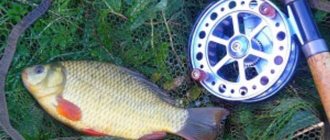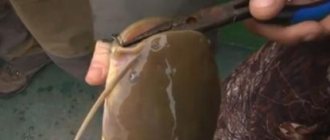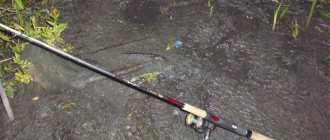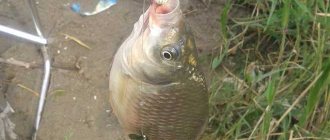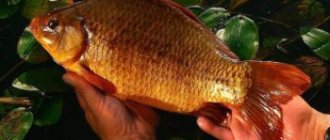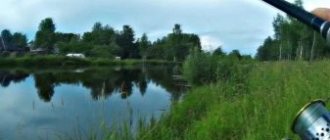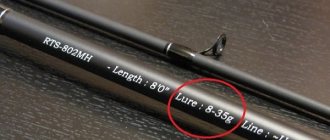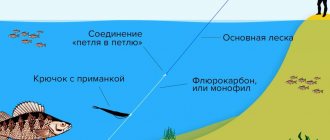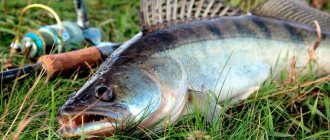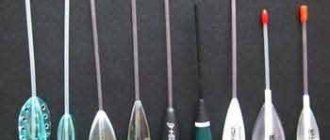How to catch crucian carp using a spinning rod
Many fishermen cannot even imagine that crucian carp can be caught using a spinning rod. In this case, we are not talking about a feeder, donk or long-distance casting gear. This is regular fishing with microjig, miniature spinners or jigs, which can easily replace jig heads. All that remains is to find out how to assemble a spinning tackle for crucian carp, what baits to use and how to achieve a good bite.
How to assemble a spinning rod for catching crucian carp
Let's start with the rod. It is best to choose ultraite or light. That is, the spinning test can vary from 1 to 7 g. There is no need for heavier gear, because you will have to catch crucian carp using miniature baits. The main thing is that the structure of the spinning rod is rigid and elastic, and the tip is as flexible and sensitive to neat bites as possible. This will allow you to better feel the wiring and play of the nozzle.
You will also need an inertia-free reel with a 1000 or 1500 spool. There are no special requirements for it, so a budget model is also suitable. The spinning rod must be equipped in a special way. The point is that the bait should be as close to the bottom as possible.
We recommend using only braided fishing line, since the sensitivity of the gear comes to the fore. Fluorocarbon is also acceptable (it is less noticeable in water), for example, as a leash. The main thing is that the tensile strength of the fishing line is from 2 to 3 kg.
Most often, the spinning rod equipment for catching crucian carp resembles a design with a retractable leash. A sinker weighing from 0.5 to 3 grams is tied to the end of the fishing line. We step back about 30 cm and tie a leash about 10-15 cm long. Now all that remains is to attach either a hook, a tungsten jig (about 2 grams in weight), or a miniature jig head weighing 1.5-2 grams.
How to equip a spinning rod for crucian carp
To catch such small fish you need a sensitive rod, so it is not at all necessary to take a long spinning rod. You should select a suitable reel, fishing line, the desired number of hooks and sinkers. If you collect your gear correctly, it will make your fishing more successful.
Read How to properly cook millet for fishing
Pay attention to how to stew crucian carp in a frying pan and in a slow cooker.
Rod selection
For catching crucian carp, a sufficient length of spinning rod will be 2.4 m with a test load of up to 5–7 g. An ultralight rod with a monolithic and flexible Solid Tip tip is suitable. It must have a fast or ultra-fast action, so it is better to abandon telescopic options. However, you can also use composite materials: although they are heavier, they are resistant to damage.
A carbon fiber product would work well. Its lightness and short length will guarantee high sensitivity.
fishing line
The rod should be equipped with ultralight or light braid with a cross section of 0.1–0.2 mm. It is durable, low-stretch and responds faster to bites. Its disadvantages are its higher price and the fact that it is more difficult to untangle.
Did you know? For thousands of years, fishing lines were made from horsehair, and sometimes from cotton or linen thread. The very first artificial material for them was nylon, invented in 1937 by scientists from an American laboratory.
It is better to use fluorocarbon for a leash, as it is almost invisible in the water and will not scare away the fish.
Coil
A small spinning reel of size 1000–2000 is suitable for a spinning rod with an ultralight rod. It fully matches this type of rod and line. The friction brake must be of good quality and smoothly adjustable to prevent the fish from trying to get off the hook. The crucian carp may be small in size, but it will resist to the end.
Here you can read about how to deliciously cook crucian carp in the oven.
Hook
For small fish, it is enough to purchase single hooks No. 3.5–7 (according to domestic numbering) with a standard shank. Its sting should be slightly bent inward, since with this shape it is more convenient to hook fish. For a crucian carp weighing only 200 g, a hook No. 3.5 is sufficient, and for a half-kilogram individual you will need No. 5–7.
Did you know? Crucian carp have an excellent sense of smell and notice parts per million of substances secreted by the inhabitants of the reservoir. They are also real drug addicts who can be lured by the smell of garlic, fragrant edible oil, Corvalol, valerian or even kerosene.
They are attached to a leash 10–15 cm from the sinker located at the end of the fishing line. There can be up to 4 leashes. Experienced fishermen, when catching crucian carp from a muddy bottom, prefer to choose black hooks. You can use a jig head (2 g) or a tungsten jig (weighing about 2 g).
Sinker
You can use a sinker weighing 0.5–3 g. It is attached to the very end of the main fishing line. It is better to mount it using a swivel so that it can be easily replaced. There should be 30 cm from it to the point of connection with a leash 10–15 cm long. You can hang a feeder next to the sinker.
Find out also how to cook crucian carp in the oven in foil.
Lures for spinning carp fishing
If you are fishing with nanojig, then first of all try small silicone baits and vibrating tails. Even the so-called edible flavored rubber is best:
It has been proven that crucian carp take more actively on edible rubber than on simple twisters. Can be applied to silicone baits and attractants to attract fish with a stronger scent. Just remember that crucian carp have a small mouth and all baits should be of the smallest size.
Catching crucian carp with a spinning rod is also possible using jigs. Their weight should be from 0.5 to 2 grams. As you already understand, such large and heavy jigs will replace jig heads. You can also attach artificial bloodworms and maggots to them. Various twisters in the shape of worms, invertebrates or insects are perfect.
Remember that the jig head for catching crucian carp must be dark in color.
This will make it invisible, and the bait on it, on the contrary, will be more natural and attractive. Bright silver colored jig heads will spook fish, so avoid using them.
Most fishermen who practice fishing for crucian carp using spinning rods recommend that you carefully select twisters or vibrotails. For example, a bait with one small tail, dim coloring and a ribbed body is preferable. At the same time, the same twister can be placed crosswise on the hook, which will give it additional attractiveness in the water.
Features and techniques of catching crucian carp using a spinning rod
Don't forget that spinning tackle definitely requires wiring. Otherwise, it will resemble a donka. Rotate the reel handle slowly and smoothly. Sudden jerks and movements should not be made, because crucian carp is a peaceful and timid fish. In addition, slow tracking will give him the opportunity to better examine his future prey and swim to a close distance to it. Therefore, only light playing with the tip of the spinning rod is allowed.
Quite long pauses of up to 10 seconds are also required. This is due to the fact that crucian carp are slow and first study the bait before trying it. If your goal is a large crucian carp, then the wiring should be even slower. The fact is that such fish are even more careful and are almost always at the bottom. Therefore, long stops will not be unnecessary.
After casting, you must also wait a few seconds, allowing the bait to sink to the bottom. After which you can do a few twitches. Now, as mentioned above, we alternate pauses and wiring. Bites mainly manifest themselves in the form of frequent and light twitches. Large specimens, on the contrary, “sit” firmly on the hook and bend the ultralight with powerful resistance.
When fishing, it is important to hook crucian carp correctly
At the same time, be prepared that most bites occur at the beginning of the pause. It looks like someone is pulling the line to the side. It’s not worth doing the hooking right away. The crucian carp needs to be given time and the opportunity to grab the bait. Therefore, wait one or two seconds, move the rod forward a little and then hook.
On different bodies of water, crucian carp can react differently to the same bait game. So don't be afraid to experiment. For example, take longer or shorter breaks. When the water warms up above 20°C, it is better to try “itchy” retrieving - instead of stopping, make rhythmic movements with the spinning rod to the side. However, in any case, throw the bait at a right angle. This way it will sink to the bottom more slowly, attracting fish.
Those who are accustomed to catching crucian carp only with a float rod or bottom tackle wonder why this fish bites on spinning baits. This is due to the crucian carp’s interest in everything moving in the water. Just remember that when fishing with a float, you often pull the rod and line just a couple of centimeters, and a bite follows in a moment.
Spinning is not used as the main fishing tackle for crucian carp
However, this fish rarely feeds in this way. She prefers to look for food in the mud and at the bottom. In addition, the peculiarities of the body structure of crucian carp and its habits do not always allow it to react in time to a bait floating nearby in the form of a jig, twister or vibrotail.
First of all, this is an opportunity to diversify your fishing or try options for gear and bait that are more often used for fishing for predatory fish. In addition, be prepared for the fact that the catch with a spinning rod is often less than with a float rod or the same feeder. Whatever one may say, crucian carp is a peaceful fish and the gear for catching it must be appropriate. While spinning and microjig are an excellent option for perch fishing.
Additional information about spinning will be discussed in the video:
Where and when to catch crucian carp on a spinning rod
In order to catch crucian carp well with spinning tackle, you need to pay special attention to the reservoir. A small lake with a large concentration of peaceful fish is best. The best option is a pond where there are many snouts and palms weighing from 100 to 200 grams. Where there are few crucian carp, it is definitely not worth catching them with a spinning rod. Fishing in reservoirs with predatory fish is also unpromising. Mostly perch and pike will bite, scaring the crucian carp away from the bait.
Be sure to take weather conditions into account. It is best to catch crucian carp using a spinning rod in warm weather, but not in the heat. At high temperatures it is not active; when it gets cold, it goes into holes and depths, where it is difficult to attract it even with the most interesting bait and game.
Promising places for catching crucian carp with a spinning rod are the borders of water and vegetation. For example, areas overgrown with reeds. A good point would be a difference in depth, even if it is only half a meter. It is also worth paying attention to places of aquatic vegetation on the border with the dump in depth.
In early spring, you can successfully catch crucian carp using a spinning rod in shallow water, where the fish go to search for food after winter. In summer, it is better to find holes 1 to 2 m deep, as well as creeks protected from the wind. However, the ideal time for catching crucian carp with a spinning rod is considered to be the days after the ice melts. The fish have a real hunger, and the search for food is difficult due to the muddy water.
In addition, do not forget that catching crucian carp with a spinning rod requires constant movement. First you need to find a promising point. However, several casts can spook the fish. In this case, you must immediately move to the side in search of a new crucian carp site. Try to fish also distances close to the shore. Still, crucian carp rarely feeds at depth. Therefore, guiding along coastlines can also be effective. Especially if there are bushes or reeds growing nearby.
Catching crucian carp on a spinning rod with a micro jig
Crucian carp is the most common fish in our reservoirs. It is from catching this fish that the fascinating world of fishing begins. For this, at first a regular float rod is used, but over time, when new gear begins to appear in their hands, many fishermen forget about crucian carp and switch to fishing for larger fish or predatory ones. At the same time, few people know that crucian carp can also be caught on a spinning rod using a microjig. This approach allows you to fish in the immediate vicinity of your home, if there is at least some body of water nearby where this fish is found.
As noted in various publications, crucian carp is a peaceful fish that prefers small invertebrates and plants in its menu. Despite this, crucian carp can be caught using a spinning rod, and quite effectively. It is very important to take this process seriously. You should start hunting for crucian carp using a spinning rod in a body of water where only peaceful fish are found and most of them are crucian carp. This is the only way to decide on the technique for catching crucian carp using a spinning rod.
Spinning tackle
Considering that crucian carp is not a big fish, although it can grow to a respectable specimen, then you will have to select only the minimum size bait. A very important factor is the choice of rod and line selection. The main thing is that the tackle allows you to control the bait and record bites.
Rod
If you plan to fish with very small baits, then the rod must be appropriate. The test of such a rod should not exceed 5-7 g. The action of the rod is super fast or fast, and the length of the blank cannot exceed 7 feet. This is a rod with a Solid Tip tip, which is also very flexible, otherwise it will not be possible to control the bait and record very thin bites. Inexpensive models include Aiko Margarite II 195-ULS, Favorite Blue Bird 682 SUL-S, and more expensive ones include Graphiteleader Calzante GOCAX 762-UL-S 0.5-5.
fishing line
Since the tackle must be very sensitive, preference should be given to braided line. A fluorocarbon insert, 0.5 to 1 meter long, which can be located between the bait and the fishing line, will not hurt. In other words, the bait should be attached through a fluorocarbon leader. The strength of the fishing line does not matter much, but still a 2 or 3.5 kg fishing line is just right. You can pay attention to the fishing line Sunline Super PE#0.6, Salmo Elite Braid 0.09, Berkley Nanofit 0.08. Among branded, more expensive ones, you can take braid from Sunline-PE EGI HG #0.4, Rockfish PE #0.3 and PE SWS Small Game #0.2-0.3.
Coil
The reel is also selected depending on the purpose of the gear. In this case, the reel must be of sufficient quality, since thin fishing line is used. In this case, evenness of winding and smooth running are crucial. It is imperative that the reel has a smoothly adjustable friction brake. Inexpensive models such as Okuma RTX, Mitchell Avocet Gold 4 are suitable; among expensive models, you can take Shimano Nasci and Skimano Stradic C14.
The right baits
Since you plan to catch crucian carp using a microjig, you need to use silicone baits of the smallest sizes. Moreover, the bait should be made of edible silicone.
- You can try silicone maggots and bloodworms from Berkley, as well as protein worms.
- Twisters and worms (of the smallest size) from companies such as Crazy Fish, Crazy Fish Crayfish, Allure or Reins Ring Shrimp, which imitate various invertebrates, will be no worse.
For equipment, you should use two-gram jig heads, but no more, otherwise the bait will not sink so slowly.
Technique for catching crucian carp using a spinning rod
Crucian carp, like other fish, moves through a reservoir along a previously set route, which is constant. Moving along his paths, he makes stops at certain points. These points may be places where crucian carp take food. Most reservoirs have coastal thickets of reeds, which are a place where crucian carp can look for food. As a rule, it moves along the border of such thickets. This is the place where you need to throw the bait. It is advisable that the bait be carried out in close proximity to the thickets. If the thickets are not dense, then you can make several casts deep into the reeds. At the same time, you need to remember that snags are possible, as a result of which the bait may be lost.
Crucian carp can also be found in windows of clear water among thickets of aquatic vegetation. But in these places, in addition to jig baits, you can use a split-shot rig, since here the crucian carp can be in the middle layers of the water. Retrieving should not consist of fast or jerky movements. Movements should be slow and even, with pauses and playing along with the tip of the rod. In order to correctly carry out maneuvers during spinning fishing for crucian carp, it is better, first, to practice somewhere in the shallows.
Larger individuals generally stay at depth. In order for a large crucian to bite, you will have to work hard, using several types of wiring. The main condition for effectiveness is the use of creeping wiring along the bottom of the reservoir. At the same time, you need to ensure that the movements are slow with long pauses. Crucian carp is quite slow and cunning, especially large ones. He will watch the bait for a long time and if something alerts him, he is unlikely to take it.
Using the flipping method, crucian carp can be caught in the gaps of grass thickets. The essence of the method is precise, short casts into nearby windows. If fishing is done from the shore, then for flipping fishing you will need a long rod. At the same time, you need to take into account the fact that the bait needs to be carried out at depth, which is not entirely convenient. This method can be easily implemented if you have a boat.
Such fishing shows good results in the spring, when crucian carp look for shallow water to bask in the sun. In addition, crucian carp does not forget about food, since it needs to gain strength before spawning. If there are reed thickets, then finding crucian carp is not so difficult. Especially in calm weather, when you can visually see how individual reeds move. In the spring, there is a high probability that a fairly large specimen will be caught on a spinning rod.
After the ice has disappeared from the reservoir, especially for 2-3 weeks, it is quite difficult to detect crucian carp, since it is not that active yet. Therefore, fishing will have to be done by touch, fishing promising places one by one. In such places there can be differences in depth, and not very large, up to half a meter. These are the so-called dumps and edges, where there are thickets of last year's grass. Casting must be done so that the bait remains in the fish’s field of vision for a long time. This principle is quite suitable for autumn fishing.
In summer, when reservoirs are overgrown with aquatic vegetation, it is better to use a boat to search for crucian carp. During this period, crucian carp are attracted to vegetation and shallow depths with the presence of clean, clear water.
The bites of crucian carp are very accurate, so it is very important to notice it in time and hook it. But during the pre-spawning feast, the crucian bite can be confused with the perch bite, it is so effective. You can control the bite of crucian carp using a fishing line lying on the surface. In short, to learn how to catch crucian carp using a spinning rod, you need to experiment to catch the very essence of fishing.
Fishing for crucian carp with a spinning rod allows you to save time, since you don’t have to go to large bodies of water or rivers for fish, since crucian carp can be found in any body of water.
Crucian carp on a spinning rod - video review
Igor 10/31/2016
fishingday.org
Is it possible to catch crucian carp using a spinning rod?
Spinning is used to catch predatory species of river fish, but recently, due to the emergence of a huge number of different gear and baits, catching crucian carp using this device has become popular. The main thing is to choose the right equipment for spinning. Although some fishermen prefer to use a float rod the old fashioned way.
Crucian carp, like many other small river fish, are wonderfully caught using spinning rods, especially if you choose the right place for fishing. It is imperative to take into account the leisurely lifestyle of this river inhabitant. This fish gets food from the muddy bottom of the river, so the bait should sink closer to the bottom of the reservoir. Accordingly, bottom fishing techniques are used.
Fishing for crucian carp using a spinning rod
| I have been active fishing for quite some time and have found many ways to improve the bite. Prices are lower than others!!!! And here are the most effective:
|
Not so long ago, catching crucian carp using a spinning rod was absolutely not taken seriously. But in recent years, the attitude towards this type of crucian carp fishing with a spinning rod has changed a lot. This type of crucian carp hunting is becoming more and more common, and therefore deserves a separate and detailed consideration.
Peculiarities of crucian carp behavior
Crucian carp are quite peaceful aquatic creatures; for the most part, this fish is simply quietly searching for food, digging in the silt deposits of the surface of the bottom relief. This fish actively devours invertebrates, larvae, insects, and various types of vegetation.
The activity of crucian carp may either subside or increase. There are periods of his particular capriciousness. When catching crucian carp with a spinning rod, you should arrive in time at the moment in time when the fish, so to speak, is in a good mood, and therefore the crucian carp will eat almost all the presents.
The main periods for catching crucian carp are spring days, fishing in summer and autumn. Although in summer it is a little more difficult to catch this fish. This is due to the large number of natural types of crucian carp food in the reservoir itself. Therefore, fishermen most often practice catching crucian carp with a worm.
But on autumn days, fishing for crucian carp with spinning rods again becomes more preferable. Crucian carp begins to actively build up the fat base necessary to survive the winter period. Fishermen have noticed that if there are pikes in a reservoir, then a large individual of crucian carp is absolutely found in this reservoir.
Choosing a place to catch crucian carp
For this type of crucian carp fishing, you should select not particularly large crucian carp lakes or ponds. In reservoirs where there are few crucian carp, you should not catch crucian carp using spinning rods.
In addition, you need to coordinate your fishing with weather conditions. If the air temperature is high, this fish will not actively bite. If it is too cold, the crucian carp also tends to lie to the bottom. The best areas for fishing for crucian carp with a spinning rod are places in the reservoir located directly near the reed bushes, on the borders of various aquatic vegetation and clear spaces of water in reservoirs.
You can also try catching crucian carp in the middle of the reeds themselves, but this fishing area will contribute to more frequent hooks. Near the shores in shallow areas of lake-type reservoirs, because near the shore you can often find crucian carp all kinds of larvae and insects that fall into the water from the shore.
You should not catch crucian carp with spinning rods in windy areas of the reservoir. In general, when fishing with spinning rods, you will have to thoroughly move along the coastline in order to find the ideal fishing spot; in the fall, fishing with a spinning rod will be little successful as crucian carp changes its diet, and what is the best way to catch crucian carp in October, read this article.
Lures for spinning carp fishing
When catching crucian carp with a spinning rod, you can try the nanojig method. You should use silicone baits such as all kinds of shrimp, imitation squid and fish. Moreover, these baits may have the same flavoring aromas of shrimp or squid, the smell of garlic or fruit, or the aromas of strawberries.
Many anglers note that crucian carp are best caught using edible rubber baits. In addition, you can use the process of applying various aromatic additives of various types to these baits. With this fishing method, you can use jigs.
Fishermen also use twisters that are not too large. Jig heads should not be chosen in silvery colors; these parameters can scare away crucian carp. Shades of dark colors should be used. Some anglers use a combination of rubber baits and baits of animal or plant origin. For example, they use maggots or worms, as well as canned corn or its boiled versions.
How to make a spinning rod for catching crucian carp?
To catch crucian carp using a spinning rod, you must correctly assemble the spinning rod itself, because the hunt will not be for a predator. Here you should select a rod that is ultra-light, with a weight load of around five or seven grams.
This rod should be equipped with a monolithic glued tip, which will provide sufficient flexibility and special sensitivity. Telescopic rod options are not a viable option.
Due to the many joints, the rod itself may break. Moreover, these rods are distinguished by their slow action type. And you should go for crucian carp with a light and fast rod.
Fishing technique and tactics
When carrying out spinning fishing for crucian carp, casting should be done at right angles, so that excessively slow crucian carp can fully inspect the proposed prey. You should also cast to the edge of reed thickets, where there is a wide variety of food for crucian carp.
If there are windows in the grass vegetation, you can throw it there. Wiring is done with slow and smooth movements, while making short pauses. Excessively sudden movements during wiring can only scare away crucian carp, which are quite timid.
technique for catching crucian carp using a spinning rod
You can use a technique called creeping wiring. With this type of fishing, the bait drags along the surface of the bottom of the reservoir at a slow pace, sometimes making some pauses.
You can use the so-called flipping method of wiring, when the process of quickly catching clean water from nearby windows is carried out. You can fish with spinning rods and from a boat, in which case you can fish the trails of crucian carp.
Features of catching crucian carp using a spinning rod
Catching crucian carp with a spinning rod requires a slow retrieve with short pauses. When hunting for large-sized crucian carp, you should lengthen the pauses in the retrieve so that large-sized crucian carp can get used to it and not be afraid of this bait.
When catching crucian carp using this method, you should definitely experiment with different attachments and baits. Crucian carp is such a fish that in one body of water it can behave differently in different places. During the fishing itself, the taste preferences of the crucian carp itself may change. The crucian carp themselves are quite slow, so they need some time to react to the bait. Therefore, one should not be surprised that instead of crucian carp, an angler can catch perch.
It is better to try such a reservoir for catching crucian carp with spinning rods, where there will be a lot of this fish and it will be its only fish inhabitant. Using this method you can master the most basic parameters of spinning fishing for crucian carp.
In addition, it should be taken into account that crucian carp are more interested in the situation, which is located at the bottom of the reservoir, and not above the fish’s head. Therefore, crucian carp sites can be found even under the very shore.
Tips for beginners
- To catch crucian carp using a spinning rod, this rod simply must be ultra-light and have high sensitivity characteristics.
- You should not make noise when fishing for crucian carp, because these fish are very shy.
- Retrieving when catching crucian carp with a spinning rod should be done with fairly smooth and slow movements, excluding all kinds of jerking actions.
- To make the bait itself more attractive for this fish, slightly lubricate this bait with aromatic substances containing pheromones.
- When catching crucian carp with a spinning rod, experiment with baits and attachments.
Fishing for crucian carp using a spinning rod video:
severtexno.ru
Where and when to fish
Crucian carp, due to their measured and slow lifestyle, does not quickly respond to bait. But other river fish (for example, perch) are more active and get hooked more often, so it is important to choose the right area of the reservoir where crucian carp are found. They prefer to live in small lakes with peaceful neighbors. A pond with a lot of “spots” and “palms” weighing up to 200 grams is perfect.
Attention should be paid to the demarcation line between water and vegetation. Places with reeds are good.
If there are predatory fish on a section of a river or in a reservoir, then it is better not to look for crucian carp there. Predators will react faster to the bait and will scare away smaller and timid fish. It is worth looking for differences in depth (slopes, edges) where there is vegetation.
In autumn, crucian carp bite until frost, but not as actively as in summer. It is difficult to catch it in winter, as it goes deep and is inactive. Fishing should begin no earlier than the ice melts from the river.
In hot weather, it is better to catch this fish at night.
At the beginning of spring, fishing is more promising in shallow water, near the shore, where crucian carp appear immediately after wintering in search of food. During this period, you need to pay attention to areas of the reservoir with remnants of vegetation from last year. Spring fishing is the most effective, as the fish are active in order to obtain food. In summer, it is better to pay attention to holes with a depth of 1–2 meters and creeks that are protected from gusts of wind.
Techniques for catching crucian carp using a spinning rod
Crucian carp, as well as other white fish, have their own travel routes and characteristic points where they linger. One of these places can be called the reed border, along which crucian carp constantly moves in search of food.
Here it is very important to bait the bait as close as possible. And if the reed is quite rare, then a few deep casts will be useful.
Almost the same applies to fishing in windows among vegetation and along the borders of overgrown areas. But in windows, in addition to mounting on a jig head, you need to use a split shot. This is due, first of all, to the fact that in windows the crucian carp is very often found at medium depths and higher, and therefore it is necessary to place the bait precisely in this horizon. Wiring consists of a slow rotation of the reel with pauses and light play along with the tip of the spinning rod. Smooth movements are important for crucian carp, so you should not make sudden jerks. You can even start by practicing in shallow water, perfecting your movements.
Photo credit: https://pro-fish.com.ua/
Large crucian carp spend more time on the bottom, and creeping wiring has the greatest chance of inducing it to bite. But the speed should be minimal, and the pauses should be longer than in fishing for pike perch and pike perch. This is due to the fact that crucian carp are very slow and look at the bait for a long time before trying it.
It is interesting to catch crucian carp in gaps among the grass using the flipping method. It consists of short targeted casts into the nearest windows and quick fishing. So, moving from window to window, you can cover a long distance and quickly find active fish. However, this method requires sufficient depth (at least a meter) and a long rod if we are talking about fishing from the shore. In the case of a boat, everything becomes much simpler.
Read What atmospheric pressure is considered normal for fishing in different regions
The most effective fishing for crucian carp is in the spring, when the fish gather in small schools and go out into shallow water. During this period, crucian carp feeds very actively, preparing for spawning. You can visually detect crucian carp by the movement of individual reeds. Despite the fact that this method works until the fall, in the spring the chances of catching a large crucian carp are significantly higher.
In early spring, two or three weeks after the ice melts, the crucian carp does not visually show itself, so the scheme of rapid movement with fishing at the boundaries of last year’s grass and shallow waters works here. The most promising areas are those where grass grows deep along the edge of the dump. Even if the depth difference is only half a meter, such a point is promising. The fishing tactics in this case are the same as when fishing for pike perch, but adjusted for depth
That is, special attention is paid to the fall and edges. Casting is best done at an acute angle to the edge, so that the bait remains on the drop in the fish’s field of view for as long as possible
The same is true for late autumn.
In summer, you will need a boat to search for crucian carp trails. It is best to search in the upper reaches of large ponds and reservoirs, where there are two factors that attract crucian carp - vegetation and shallows. An important criterion for such a search is transparency and low depth. You need to move chaotically, carefully peering into the water and marking the places where the crucian carp was spotted. After walking some distance and marking several points, you can begin targeted fishing. Although the large crucian carp is shy, it does not change its hunting paths and soon returns. Thus, even a seemingly hopelessly scared crucian carp will end up at the point (or nearby) where it was spotted.
The bite of a large crucian carp is a short poke and pull. However, during the spring feeding season, the bite can easily be confused with a perch bite. In autumn, the bite feels like a smooth and short pull
In general, crucian carp bites are very accurate, and therefore it is very important to pay attention to the general sensory of the gear. If this is difficult to do, then the bite needs to be controlled by the fishing line. Or rather, over a small area lying on the surface.
Or rather, over a small area lying on the surface.
Spinning fishing for crucian carp, despite certain technical difficulties, is of great practical interest. The size of the fish caught varies, but on average they are larger than those caught on a regular float rod. In addition, crucian carp is a kind of substitute for “real” fish when it is not possible to travel far or you have a limited time limit for fishing.
Lures for spinning fishing
Crucian carp have a small mouth, so the bait should be small and narrow. When using a spinning rod, choose spinning baits made of silicone up to 2 cm in size, which resemble worms, leeches, crustaceans, maggots, and bloodworms. Twisters and slugs are perfect.
The combination of baits of animal and plant origin gives the best results.
Out of caution, crucian carp always first tries the bait and, if nothing repels it, swallows it, so you need to choose edible silicone. Fragrances are often applied to baits to attract fish. They are also equipped with jig heads weighing up to 4 g. Meat baits - maggots, bloodworms, worms and larvae - are also good. Vegetable options include corn (boiled or canned), barley or millet porridge, and bread crumbs.
Techniques and tactics of catching crucian carp using a spinning rod
After finding a good area for catching crucian carp, you should accurately throw the tackle into a section of the river with dense vegetation. It would be a good idea to feed the chosen place before fishing. It is better to cast at an angle of 90° so that this rather leisurely fish notices the bait.
The bait is moved along the bottom slowly, with long pauses (10 seconds or more). When stopping, you need to move it, but so that the weight remains in place. Sudden movements of the bait should be excluded, as the crucian carp may simply get scared of them. In the daytime, almost the same actions are repeated in the water column, and not along the bottom.
When the crucian carp bites and the line is pulled to the side, do not rush to hook, give it 1-2 seconds to swallow the bait. Then the fishing rod should be moved slightly forward and hooked.
Catching crucian carp with a spinning rod will be exciting and productive if you equip it correctly. An important factor in successful fishing will be a good choice of time and place for it.
Where there is no pike, there is a crucian carp, catching crucian carp with a spinning rod
Everyone gets caught with a spinning rod. Take, for example, crucian carp. Just a dozen years ago, catching this fish with a spinning rod was considered unpromising, pampering, in a word. But now the popularity of spinning has increased so much that even crucian carp are successfully caught with it.
If you are fishing in a reservoir where there are almost no other fish besides pike and crucian carp, then you will often come across crucian carp. But where there are many other species of fish and bass are present, your catch will be dominated by the striped predator. But anyway, you’ll catch a crucian carp. Sometimes in some reservoirs, large crucian carp stay far from the shore. This is usually in those lakes and ponds where village birds or livestock muddy the water in shallow waters. In this case, spinning can work well.
Crucian carp on a spinning rod
Spinning
The rules for catching crucian carp with a spinning rod are such that light tackle is used. Fishing must be delicate. First of all, this concerns the fishing rod. Choose a stick with ultralight dough, that is, up to 7 grams.
Since the tackle is light, it should also be sensitive. Accordingly, the rod needs to choose a small reel. The main cord is 0.1 mm in diameter. The leash is also thin, almost invisible in the water; you can take a fluorocarbon one, because the crucian carp will not break it.
Lures
What can be successful in catching crucian carp? Usually two baits are used: a jig or a jig head.
Mormyshka
If you use a jig as bait, it should be heavy. A tungsten jig will do. Also, the jig should not be small and weigh about 2 grams. Artificial silicone worms are used as attachments. It would be better if it was edible silicone, that is, it had color and taste. Of course, live bait is also used, for example, a worm. Since crucian carp is a passive fish, it will first try the bait, and then, having determined whether it liked it or not, it begins to swallow it.
Silicone worms
Jig - head
You can use a jig head as bait. A jig is a small head, unlike a jig, about one and a half grams. Color matters. It is important to use a dark jig head, not a shiny one. With a jig head they use a small twister, which in its shape resembles a worm. With a jig there is a chance of catching a fairly large specimen.
Jig - head
Fishing technique
Fishing occurs as follows. The bait should not immediately fall to the bottom, it should sink smoothly. Thus, it will fall into the field of view of the crucian carp. After you feel that the bait is on the bottom, you need to take a short break, perhaps there will be a bite from the bottom. And, in general, it has been noticed that crucian carp more often takes a break.
The video shows how to catch crucian carp using a long cast:
But in my opinion, catching crucian carp with a spinning rod is a matter of chance and a lot of patience. I myself didn’t go specifically for crucian carp with a spinning rod, but I came across it by accident. This happened very unexpectedly. I happened to live for several days in the lap of nature, in a small village. I took only a light spinning rod from home and in the evening, after the heat had subsided, I went to the local lake. I was going to catch perch, relax, and at the same time bring dinner to the cat. He wasn’t fishing alone; several village fishermen settled nearby. I was the only one with spinning gear. The locals fished with donka. They were slowly dragging small crucian carp. I also had one perch bite, by the way, too small. Since I didn’t particularly prepare for fishing, I was glad about that. The only baits I took from home were jigs and silicone noodles. Of course, this will not surprise anyone, but for the locals there was a topic for conversation. Like, why is this necessary, when even the worm bites. Maybe they were right. About two hours later, when I was ready to reel in my fishing rods and go home, the bite happened. I immediately felt it was not striped. When being fished out, a crucian carp begins to flounder, and by this sign you can recognize it, but I could not even imagine that it was him. I managed to hook, twist and pull out a decent crucian carp. What surprised the local fishing community.
Folk sign: If the first fish fails, then the fishing is unlikely to be successful.
kakulov.ru
How to assemble and properly equip a spinning rod for beginners
The design of a spinning rod is simple down to the basics, but at the same time quite effective in practical use. Few tackles in their monotonous structure can play the role of a tool for completely different types of fishing.
Having assembled a spinning rod, it can be used with equal success as a tool for catching predatory fish and as a tackle for bottom fishing, a match rod and a regular fly rod. In this diversity, all that remains is to re-equip the spinning rod with equipment with attachments for the next type of fish being caught, but the main elements of the rod remain unchanged, universally fulfilling its obligations.
What gear is needed for spinning?
Any spinning tackle consists of the same set of accessories that give the rod the ability for practical use. The equipment of a spinning rod is as follows: the basis is the rod itself, consisting of a blank with guide rings for the fishing line and a handle with a mount for mounting the reel, the reel itself, the type of which may vary depending on the preferences of the angler and the fishing conditions.
The presented elements form the spinning tackle. The reel is additionally equipped with a cord, and the equipment itself is directly attached to the cord. The equipment depends on the type of fishing and can consist of weights, floats, leashes with hooks, feeders, artificial baits and a complex of all these components. As the article progresses, we will look at the equipment in the section for each component, discuss its role in the overall set of spinning equipment, and discuss how all the equipment is prepared for fishing.
Rod
The spinning rod is assembled on its base, which is called a fishing rod. Today, manufacturers make spinning tackle from the latest ultra-light materials of artificial origin, characterized by flexibility and elasticity combined with high strength.
Most often, the blank is made from fiberglass, fiberglass, carbon fiber materials and combinations of materials called composite. Depending on the type of material, the form forms a mass.
Important! A fiberglass rod is much heavier than carbon fiber rod.
The rod can be made in two versions: a plug-type version and a telescopic assembly version. The handle is made of a metal rod, finished on its surface with natural cork or dense nylon. The choice of these types of handle finishes is characterized by the high ergonomic qualities of these materials.
The tactile sensations of the fisherman with such material do not cause even the slightest inconvenience, which does not distract the catch at all. A reel seat with a threaded connection principle for attaching an accessory is built into the handle of the fishing rod. Metal line holder rings with composite or stainless steel inserts, polished to the highest degree, are glued into the tackle form. This condition is necessary to reduce the friction force arising from movement along the guide rings of the main cord.
Important! According to their performance characteristics, fishing rods are divided according to their length, action or blank rigidity, test or power for loading tackle with bait or other type of equipment.
Spinning fishermen, based on the characteristics of the stick, choose a certain type of fishing rod for the type of fishing.
Coil
The next fundamental element that makes up a spinning rod is the reel. According to their types, fishing reels are divided into inertia-free, multiplier and inertial. Devices are made from plastic and metal components. More acceptable options for fishing are reels with a metal casing.
All presented types of mechanism have in their design features unification in terms of the leg, which can be interfaced with a reel seat made on any tackle. The general characteristics of reels are their volume or line capacity and the presence of a braking device or clutch. Otherwise, inertia-free and multiplier reels differ in the type of gear ratio, characterized by the number of rotations of the mechanism handle to the number of rotations of the rotor.
Lures
The variety of artificial baits in today's realities indicates the high popularity of spinning fishing. I will list the main types of baits most commonly used in this type of fishing hobby. Some of the most famous baits are all kinds of wobblers. Wobbler is an imitation of a live fish or small animal, often a mouse or frog, which is equipped with one or more hooks. By animating the bait in the water, the fisherman provokes the predator to attack.
Silicone baits in various designs replicate the shapes of fry, worms, insects, water beetles and larvae. Silicone is additionally equipped with a hook and sinker and only then is it introduced into the equipment used when installing the spinning rod.
Spinner is a classic bait in spinning hunting. Spoons are divided into oscillating and rotating variations. Recently, spinnerbaits have become increasingly common in the arsenal of spinners. This is a combination of silicone and a spinner. When using a spinning rod for fishing, the bait can be either live or dead fish. For this type of bait, there is a special equipment technique using several double hooks with different shank lengths, connected into a single structure.
Making a spinning rod with your own hands, having acquired the components listed above, will not be very difficult. Today there is no shortage of accessories presented, and their cost can be selected based on your financial capabilities, since there are plenty of price options. It’s important to create a spinning rod for beginners from lower-priced materials. This will allow you, without regard to the financial component, to persistently comprehend the basics of this direction in fishing.
It is important to correctly tie the lure to the spinning rod, and in a separate article we wrote how to do this to avoid twisting.
Fishing technique
When fishing with a microjig, a wide variety of types of bait movements and animations are used:
Step retrieve is a classic jig step with the bait touching the bottom. Usually two or three turns are made with the reel handle, then a pause during which the bait lowers and touches the bottom
When fishing with step fishing, it is important to choose the right bait load for the specific depth of the fishing spot.
Retrieving by tossing bait is a bit like step retrieving. Tossing is done as follows: the bait is cast, wait until the bait touches the bottom, the slack line is reeled out, a light toss of the bait is made with the hand and spinning blank, then a pause, the bait falls to the bottom, the slack line is reeled out and a new toss is made
Read: What is the difference between bream and white bream in appearance and behavior?
In addition to the single toss, there is a double toss of the bait, when the hand makes two movements, then the bait makes two jumps, the first from the bottom, the second already in the water column, after which the bait falls to the bottom. Tossing makes the bait play very bright, well provoking the predator to attack.
Uniform retrieving consists of simply rotating the reel handle without stopping, while the bait moves evenly under water. You can diversify the uniform wiring with additional movements with the tip of the spinning rod. Uniform wiring shows good fishing results when the fish is in a passive state.
Wave-like wiring is performed by moving the tip of the spinning rod as when twitching. Wave-like wiring is used for fishing in the water column, while preventing the bait from touching the bottom. Wiring can be used both when fishing in currents and when fishing in still water.
How to make and equip a spinning rod for fishing
When all the components for the tackle have already been purchased, you can confidently begin assembly. Let us present how to assemble a spinning rod without errors in the form of the following list of sequential actions.
Having taken the purchased rod, we assemble it into working condition by articulating the knee for the plug-in type or pulling out the links for the telescopic type of tackle. The assembled tackle should not have any play or wobble at the joints. Then the reel is attached to the reel seat. The sliding components of the mount move along the butt of the rod, allowing you to insert the reel leg into the mount saddles. Having placed the leg in the saddle, tighten the fasteners until they are completely compressed. The correct clamping force completely eliminates side-to-side wobble of the reel.
After installing the reel, the cord is wound onto the spool of the mechanism. To do this, a braided cord is inserted into the tip of the rod, into the last ring, and passed along the entire length of the blank through the guide rings all the way to the reel. The line-laying arc opens in the reel and the cord is attached to the base of the spool. After attaching the cord, the bow is closed and the braid is wound to the required volume. Having completed winding the cord, proceed to tying the leash and attaching the bait. After securing the bait, the installation is considered complete.
To transport the spinning rod, when moving along the coastline, it is recommended to attach the bait to the bow of the line layer through a hook; in some types of fishing rods, a special fastener is provided for this purpose at the base of the blank, which makes the task easier, without deforming the tip of the fishing rod by strongly tightening the braid. Even a beginner in this fascinating business is quite capable of assembling a spinning rod correctly, following this sequence.
Types of spinning equipment
The equipment chosen for fishing will help you finally set up the gear for productive work. Below I will list the main, most common and no less effective types. The classic spinning equipment is the method of mounting a leash to the main cord with a clasp to which a bait, spoon or wobbler is attached. Wiring is also successfully used when installing silicone baits on stationary jig heads.
Spaced rigs, which include drop-shot, retractable leash, Carolina and Texas rigs, have earned great love from spinning anglers. This direction of equipment involves mounting the bait and its loading separately from each other and sometimes at a considerable distance. Progressive equipment in the spinning movement is the use of a sbirulino or bombard float. By selecting a float according to its characteristics, weight and ability to stay on the surface or submerge in water, the fisherman is able to throw small bait with tackle over a significant distance and carry out the retrieve in the desired water horizon.
Sources:
https://promysel.com/rybalka/karas/lovlya-karasya-na-spinning.html https://fermer.blog/bok/rybovodstvo/ryby/karas/lovlya-karasya/snasti-na-karasya/17034-karas -na-spinning.html https://iarybak.ru/snasti/kak-sobrat-spinning
